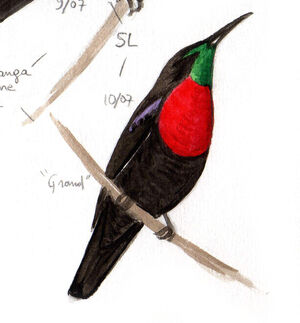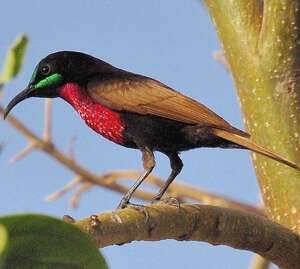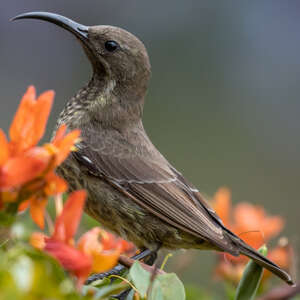Scarlet-chested Sunbird
Chalcomitra senegalensis - Souimanga à poitrine rouge
Identification
The Scarlet-chested Sunbird is a large sunbird with distinct sexual dimorphism. The nuptial male has very dark brown plumage, appearing black from a distance. It has bright red chest plumage which is an important visual specific signal. Close up, small blue spots are visible on the red background. The head features blue or green metallic looking areas in good lighting: the forehead and the crown often blue-turquoise, green moustache below the eyes, and chin and throat also green. The lesser and greater coverts, remiges and rectrices are lighter brown than the body; they become reddish-brown with wear. The black, slightly larger than head and quite strong bill is distinctly hooked. The eyes and feet are black. The female is paler than the male. The upperparts are brown with sometimes an olive tint. The wing and tail feathers are edged with white or pale beige. The entire underparts are heavily flecked or streaked with brown on a whitish background, sometimes with a hint of yellow. The dark throat is bordered by two whitish malar lines widening on the sides of the neck. A faint eyebrow streak, of the same color, is visible behind the eye. The juvenile resembles the female. It is distinguished by its yellow chin. The male acquires nuptial plumage at two years old. Initially identical to the female, the immature male progressively acquires the color attributes of the adult (red chest, bright head feathers), but the belly remains of female type. It already has a red chest and the head feathers are already metallic like those of the adult male. Subspecific variations: C. s. acik has lighter and duller red chest. The metallic blue crown is also less intense and the moustaches are smaller.C. s. lamperti looks similar to C. s. acik, with a longer beak (28 to 31 mm). C. s. acik's beak is between 22 and 26 mm. In the female, the underparts are generally paler and less marked.
The male C. s. proteus has a small purple patch on its lower coverts. The chin is black. The green moustache is paler than in the previous two ssp but still stands out. In the female, the primaries and alula have no white edging. The belly is pale yellow.
For C. s. gutturalis, the male distinguishes itself from other ssp by the purple patch on the coverts. The female possesses yellow underparts.
Subspecific information 6 subspecies
- Chalcomitra senegalensis senegalensis (s Mauritania and Senegal to Nigeria)
- Chalcomitra senegalensis acik (Cameroon to sw Sudan, nw Uganda and ne DRCongo)
- Chalcomitra senegalensis proteus (se Sudan, Eritrea, Ethiopia and n Kenya)
- Chalcomitra senegalensis lamperti (s Sudan, e DRCongo and w, c and s Uganda to c Kenya and w Tanzania)
- Chalcomitra senegalensis saturatior (Angola and s DRCongo to Namibia and n Botswana)
- Chalcomitra senegalensis gutturalis (s Somalia to e Zimbabwe, Mozambique and ne South Africa)
Foreign names
- Souimanga à poitrine rouge,
- Suimanga pechiescarlata,
- nectarínia-de-peito-escarlate,
- Rotbrust-Glanzköpfchen,
- bíbormellű nektármadár,
- Roodborsthoningzuiger,
- Nettarinia pettoscarlatto,
- karmosinbröstad solfågel,
- Skarlagenbrystsolfugl,
- nektárovka červenoprsá,
- strdimil senegalský,
- Skarlagenbrystet Solfugl,
- ruusurintamedestäjä,
- Rooiborssuikerbekkie,
- suimanga de pit escarlata,
- nektarnik szkarłatny,
- Яркокрасногрудая нектарница,
- ヒムネタイヨウチョウ,
- 赤胸花蜜鸟,
- scharlakansbröstad solfågel,
- 赤胸花蜜鳥,
Voice song and call
The Scarlet-chested Sunbird's song consists of four or five syllables with variations, chip-choop-chip-choo-choo in 1-2 seconds. Then rapid repetitions of notes go chi. A trill is more of a weetodu-weetodu alternating with a repeated note multiple times chip for ssp gutturalis and weet or weetu for the nominative race. The song sequences can last over an hour. The immature male can also sing.
Finally, the call can vary but is common among all the ssp: choop or tjoyp varying with chip-chip and tsee-tsee.
Habitat
Behaviour character trait
The Scarlet-chested Sunbird is typically sedentary but nomadic and migratory movements are noted in many populations.
Migration is generally closely linked to the climate. In fact, it occurs during dry season in Zimbabwe (March-July) and in Kenya (February-April and September-November) and during the wet season in Namibia (November-April). In Tanzania, movements are only made during the nesting season to higher altitudes. In West Africa, it moves with the rainy season.The Scarlet-chested Sunbird is monogamous. It can be seen alone or in pairs. It can be observed in groups when foraging on the ground. It can also be seen amongst herds. On the other hand, the male defends its feeding territory against other males.
Dietfeeding habits
Reproduction nesting
Generally, the breeding period extends throughout the year, but varies locally depending on the habitat and climate. In some areas there can be up to 3 broods in a year. The male territorial parades by undulating his body next to the female. It is entirely up to her to construct the nest. In as few as 3 to 6 days, the nest is built as high as possible in the middle of the green foliage and branches of the canopy to avoid any predators; however, the nest can be parasitized by Klass's cuckoo, the Lesser cuckoo-shrike, or the Large-billed crow. It is often built near a wasp, a water source, or a building.
Pear-shaped, it is composed of dry grass, dead leaves, and tree bark bound together by the silk threads of spider webs collected by the female. The exterior is covered with dead leaves, lichen, or ivy while the inside is lined with fine plant material, feathers, and hairs. The opening, positioned on the upper part of the nest, has a small porch protecting the entrance. It is securely attached to a leafy branch which is between 5 and 15 meters above the ground. The female lays 1 to 3 eggs of varying colour: dirty white, pinkish-violet to white, blue to light green with speckles. She incubates for 13 to 15 days. Both adults take care of feeding the chicks which leave the nest 15 to 23 days after hatching. After fledging, the young come back to sleep in the nest the first four nights and remain dependent on the parents for at least 8 weeks. Nonetheless, they are still capable of feeding on nectar a few days after leaving the nest. The same nest can be used for all broods of the year. On the other hand, the female can make a new one for each clutch.Geographic range
Threats - protection
Sources of information
- IOC World Bird List (v15.1), Gill, F and D Donsker (Eds). 2025-12-07.
- Sunbirds, Roberts A. Cheke, Clive F. Mann and Richard Allen
- Birds of East Africa: Kenya, Tanzania, Uganda, Rwanda, Burundi, Terry Stevenson, John Fanshawe
- Biodiversity explorer The web of life in Southern Africa,
- HBW Alive,
Other sources of interest
 Specification sheet created on
22/07/2023 by Nathalie Santa Maria
Specification sheet created on
22/07/2023 by Nathalie Santa MariaTranslation by AI Oiseaux.net
© 1996-2025 Oiseaux.net
- Accipitriformes
- Aegotheliformes
- Anseriformes
- Apodiformes
- Apterygiformes
- Bucerotiformes
- Caprimulgiformes
- Cariamiformes
- Casuariiformes
- Charadriiformes
- Ciconiiformes
- Coliiformes
- Columbiformes
- Coraciiformes
- Cuculiformes
- Eurypygiformes
- Falconiformes
- Galliformes
- Gaviiformes
- Gruiformes
- Leptosomiformes
- Mesitornithiformes
- Musophagiformes
- Nyctibiiformes
- Opisthocomiformes
- Otidiformes
- Passeriformes
- Pelecaniformes
- Phaethontiformes
- Phoenicopteriformes
- Piciformes
- Podargiformes
- Podicipediformes
- Procellariiformes
- Psittaciformes
- Pterocliformes
- Rheiformes
- Sphenisciformes
- Steatornithiformes
- Strigiformes
- Struthioniformes
- Suliformes
- Tinamiformes
- Trogoniformes






























